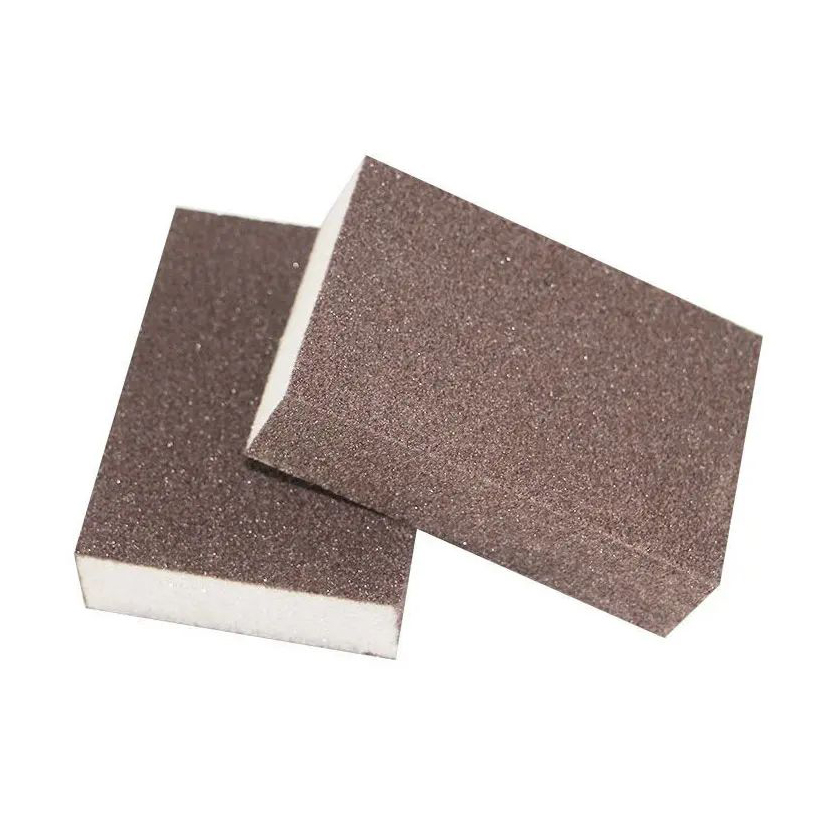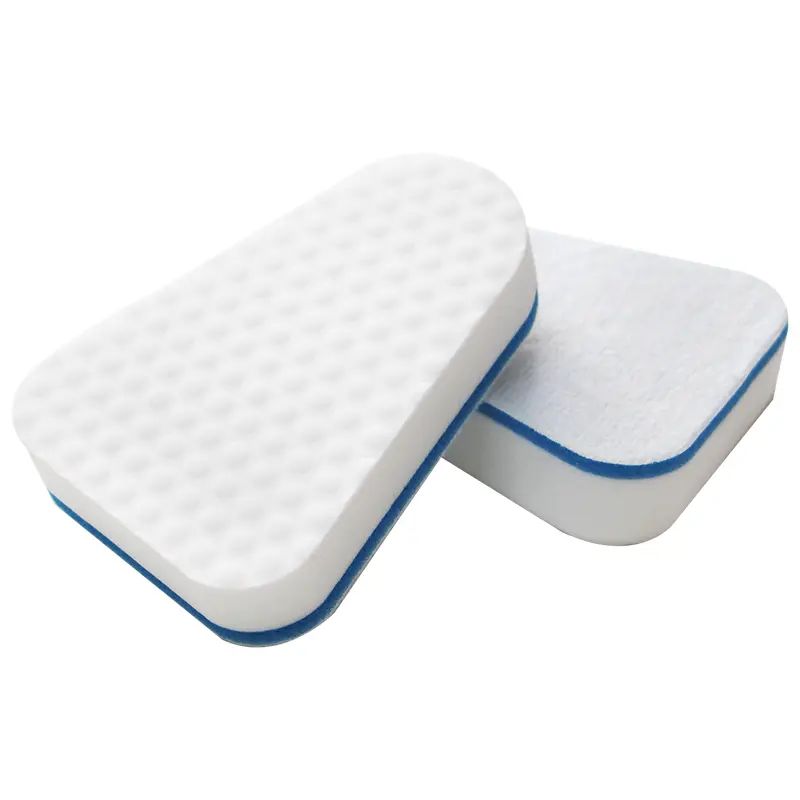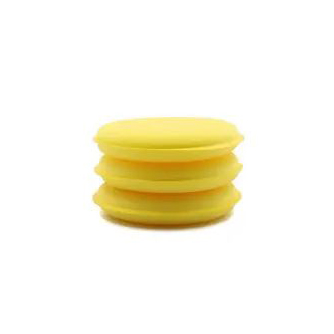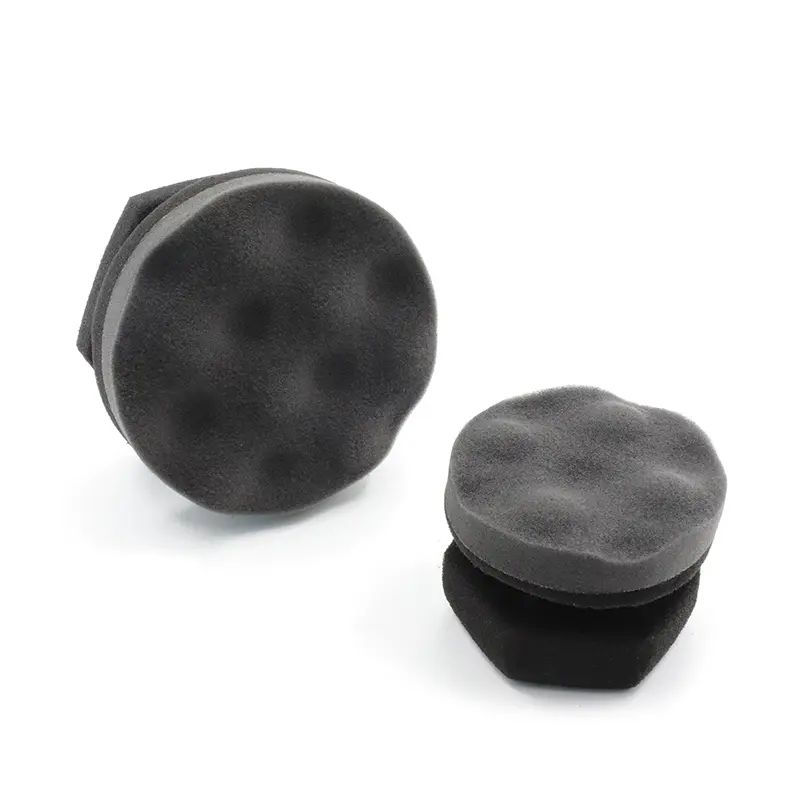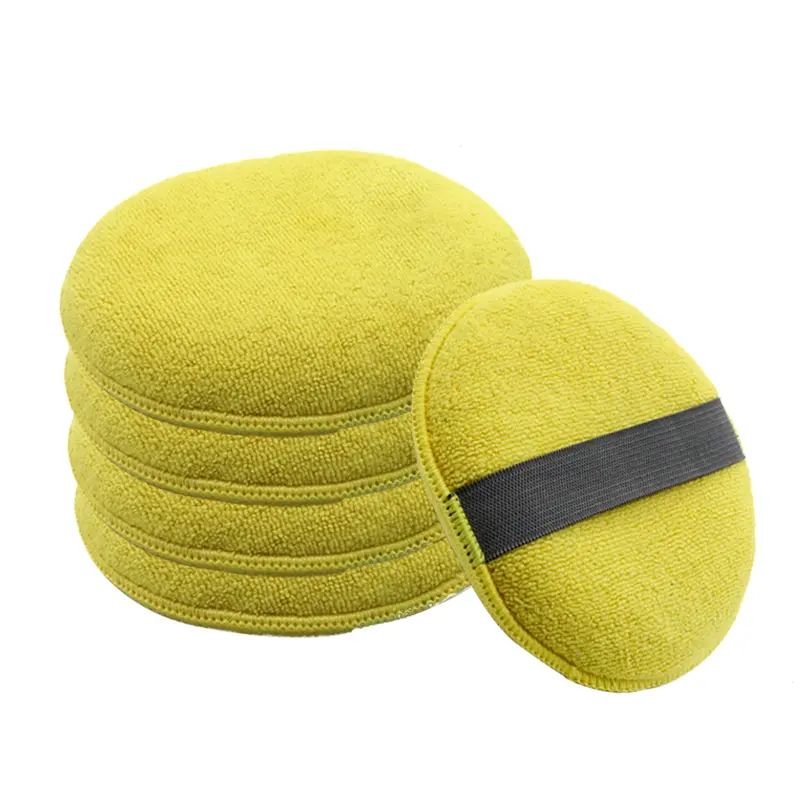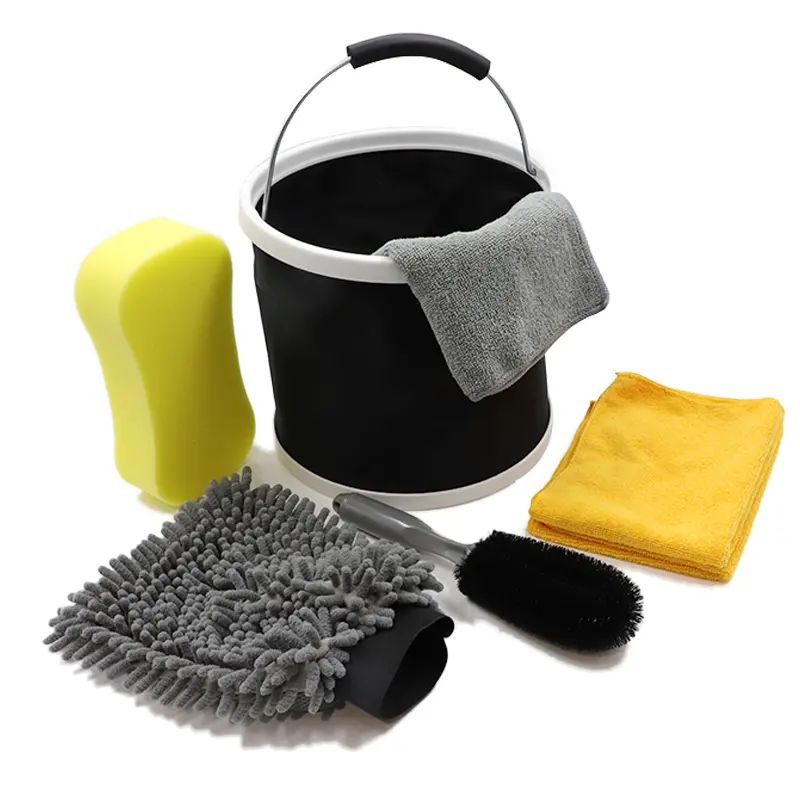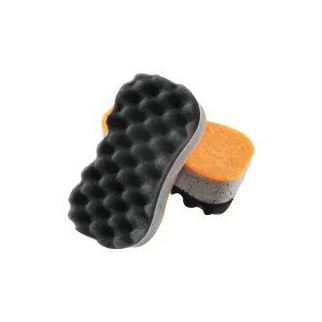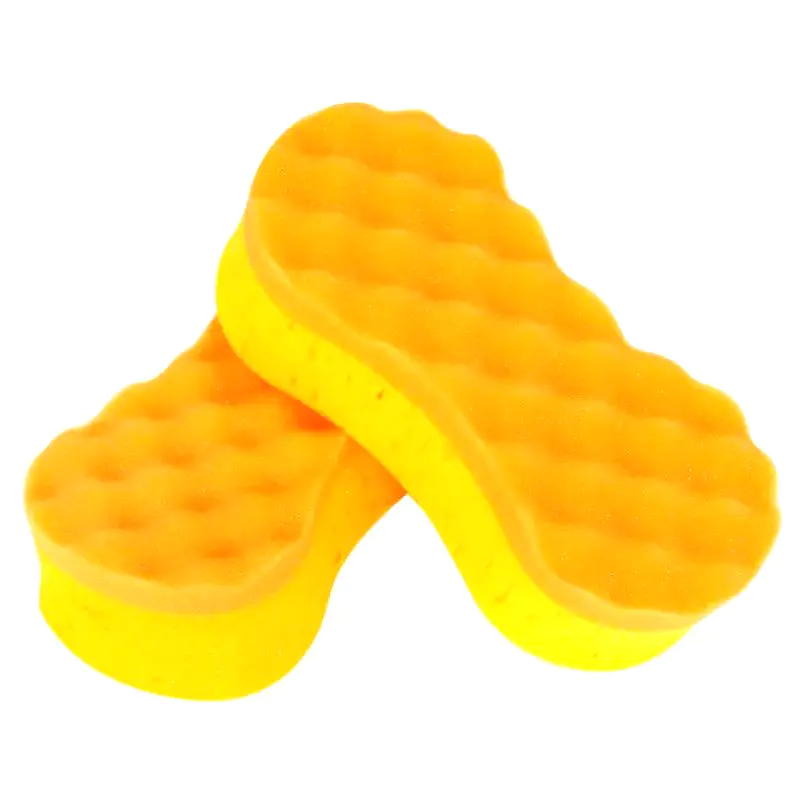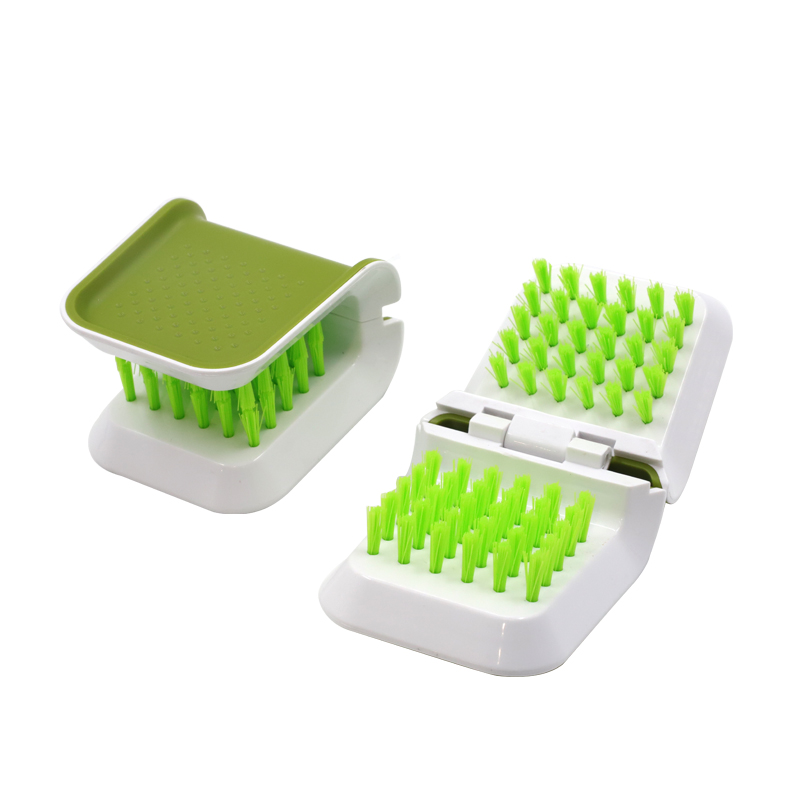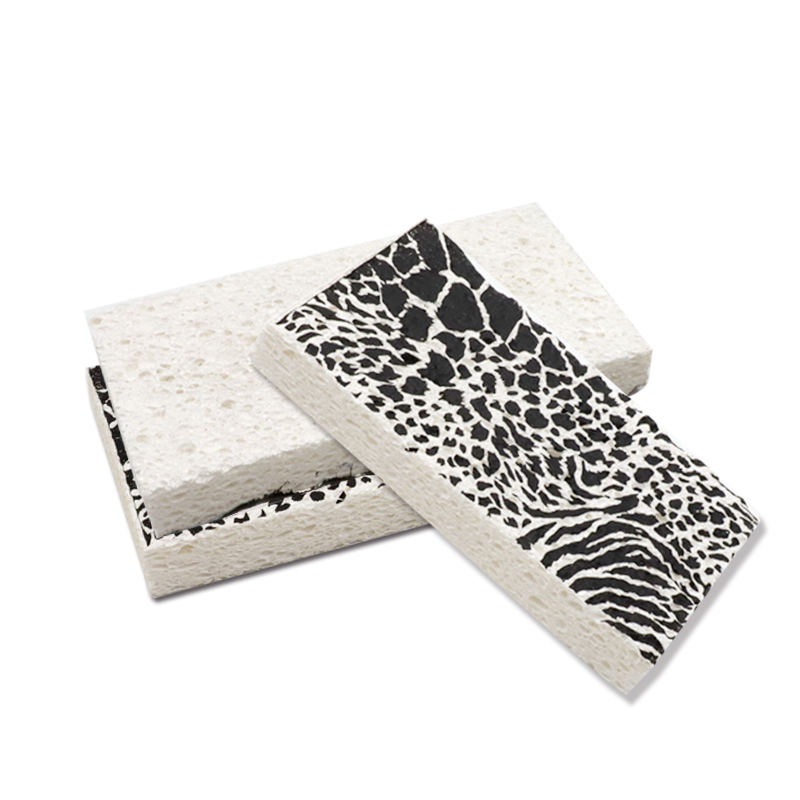How to Choose a Cellulose Sponge for Home Cleaning: A Comprehensive Guide
1. Material Selection
Cellulose sponges are an essential household cleaning tool, known for their absorbency, durability, and versatility. The material they are made from plays a crucial role in their effectiveness, longevity, and environmental footprint. Generally, cellulose sponges are made from two primary types of materials: natural wood pulp and regenerated cellulose. Each material has unique properties, advantages, and environmental impacts that make them suitable for different cleaning tasks.
Natural Wood Pulp Cellulose Sponges
Natural wood pulp cellulose sponges are typically derived from wood processing byproducts, such as sawdust and wood chips, which are then transformed into cellulose fibers. These fibers are processed to create the sponges, which are highly absorbent and retain a substantial amount of water, making them ideal for cleaning tasks that require soaking up liquids. The natural fibers in the pulp also lend these sponges an inherent softness, making them gentle enough for use on delicate surfaces without causing scratches or damage.
One of the most significant advantages of natural wood pulp cellulose sponges is their excellent absorbency. These sponges can hold large amounts of water relative to their size, which is perfect for cleaning spills, wiping down surfaces, or washing dishes. This absorbent quality helps to clean large areas with minimal effort, as the sponge can absorb liquids quickly and efficiently without the need for frequent wringing or re-dipping.
Elasticity is another key feature of wood pulp cellulose sponges. Their fibers are flexible and resilient, which allows them to maintain their shape over time even after prolonged use. Unlike some other types of sponges that lose their structure or become flat and ineffective after a few uses, natural wood pulp cellulose sponges can last for extended periods, making them a cost-effective option for households that need a reliable cleaning tool.
Natural wood pulp cellulose sponges are biodegradable and compostable, which makes them an excellent option for environmentally conscious consumers. Since they are made from wood byproducts, these sponges come from renewable resources and are capable of breaking down naturally without harming the environment. This makes them a preferable choice for people who are striving to reduce their carbon footprint and move towards more sustainable living.
There are some considerations when using natural wood pulp sponges. For example, they can sometimes be a bit less durable than regenerated cellulose sponges. Although they can last for a long time, they may wear out more quickly if exposed to harsh cleaning chemicals or abrasive surfaces. Additionally, natural wood pulp sponges are more prone to retaining bacteria and odors over time, so they must be cleaned and dried properly between uses to maintain hygiene.
Despite these considerations, natural wood pulp cellulose sponges remain a popular choice due to their superior absorbency, softness, and sustainability.
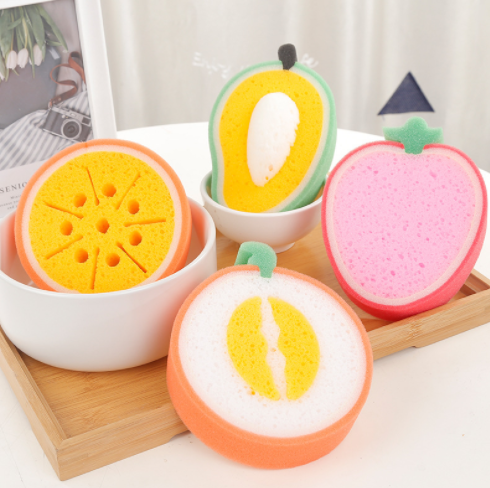
Regenerated Cellulose Sponges
Regenerated cellulose sponges are a more modern innovation in the world of cleaning tools. Unlike natural wood pulp sponges, regenerated cellulose sponges are made from recycled materials, such as used paper or other fibrous materials, which are chemically treated to create a new form of cellulose. The recycled fibers are then processed into sponges that share many of the same characteristics as natural wood pulp sponges but with some notable differences.
One of the key advantages of regenerated cellulose sponges is their environmental sustainability. Since they are made from recycled materials, they help reduce the need for new raw resources, particularly timber. This makes them a more eco-friendly option, as they contribute to reducing waste and the consumption of natural resources. In addition, regenerated cellulose sponges are also biodegradable, which means they will break down naturally after use, posing less harm to the environment than synthetic sponges made from petroleum-based plastics.
Absorbency is another area where regenerated cellulose sponges excel. While they may not be quite as absorbent as natural wood pulp sponges, they still perform exceptionally well when it comes to holding water and absorbing spills. The unique structure of the regenerated cellulose fibers allows them to soak up liquids efficiently, and they are particularly well-suited for tasks like wiping down counters, cleaning dishes, or scrubbing surfaces that need moderate moisture levels.
In terms of durability, regenerated cellulose sponges are known for being fairly long-lasting. They are generally more durable than natural wood pulp sponges, especially when exposed to harsh cleaning conditions. The fibers in regenerated cellulose sponges are tightly bonded, making them less likely to fall apart or degrade with regular use. However, like all sponges, they still need proper care and maintenance to avoid wear and tear. The key to prolonging their lifespan is to rinse and dry them thoroughly after each use.
Regenerated cellulose sponges can also be made with different textures, which makes them versatile for a range of cleaning tasks. Some regenerated cellulose sponges have a soft, smooth surface that is perfect for wiping delicate surfaces, such as countertops or glass, without scratching. Others may have a more abrasive texture, which is useful for scrubbing stubborn dirt and grime from tougher surfaces like sinks, bathtubs, or stovetops.
Despite their many benefits, there are a few downsides to regenerated cellulose sponges. They tend to be less elastic than natural wood pulp sponges, which means they may not retain their shape as well after extensive use. Over time, they may also become more prone to tearing or losing their texture, particularly when exposed to harsh chemicals or frequent scrubbing. However, for general-purpose cleaning, regenerated cellulose sponges are still an excellent choice, especially for households focused on sustainability and reducing waste.
Comparison Table: Natural Wood Pulp vs. Regenerated Cellulose Sponges
| Feature | Natural Wood Pulp Cellulose Sponges | Regenerated Cellulose Sponges |
|---|---|---|
| Material Source | Derived from wood processing byproducts | Made from recycled paper or fiber materials |
| Absorbency | High absorbency, ideal for wet tasks | Similar absorbency, effective for most cleaning tasks |
| Elasticity | High elasticity, retains shape after use | Less elastic, but still durable |
| Environmental Impact | Biodegradable, eco-friendly | More eco-friendly due to recycled materials |
| Best Uses | Gentle cleaning, dishwashing, wiping surfaces | Sustainable living, general cleaning tasks |
| Durability | May wear out slightly faster with rough use | More durable, less prone to degradation |
| Bacteria and Odor Resistance | Prone to bacteria retention if not dried properly | Prone to bacterial buildup but typically dries quicker |
2. Water Absorbency
Water absorbency is one of the most important factors to consider when selecting a cellulose sponge. This property determines how much water a sponge can absorb, how long it retains the water, and how efficiently it can be used in various cleaning tasks. A good sponge should be able to hold a significant amount of water, allowing it to clean larger surfaces with minimal effort. However, the level of water absorbency may vary depending on the intended use of the sponge. Some sponges are designed for maximum water absorption, while others strike a balance between absorption and water retention to cater to more delicate cleaning needs.
High Water Absorbency
A sponge with high water absorbency is ideal for situations where large quantities of liquid need to be absorbed quickly. These sponges can hold a substantial amount of water, making them highly effective for cleaning large areas such as countertops, floors, and dishes. When selecting a sponge with high water absorbency, it is important to understand that the greater the absorbent capacity, the more efficient the cleaning process becomes.
High-absorbency cellulose sponges typically have a loose structure that allows for a higher volume of water to be absorbed into the sponge’s cells. This loose structure creates more surface area, allowing the sponge to retain water without squeezing it out during use. The increased surface area also means that these sponges are more capable of picking up dirt, grime, and other residues, making them ideal for larger cleaning tasks.
For example, when cleaning a kitchen counter, a high-absorbency sponge will quickly soak up spills and dirt, reducing the number of times the sponge needs to be squeezed out. This reduces the effort required from the user and speeds up the overall cleaning process. Additionally, high-absorbency sponges can hold more water between uses, ensuring that the cleaning process remains continuous without frequent interruption.
The downside of high-absorbency sponges is that they tend to become heavy as they hold more water, which can make them harder to maneuver. Additionally, when these sponges are overly saturated, they may start to drip, making them less effective for certain tasks that require a controlled amount of moisture.
Moderate Water Absorbency
While high-absorbency sponges are perfect for heavy-duty tasks, a sponge with moderate water absorbency can be more suited for delicate cleaning tasks or areas where excess moisture is not desirable. A moderate-absorbency sponge holds a balanced amount of water, allowing it to perform cleaning tasks without leaving excess moisture on surfaces.
Moderate absorbency cellulose sponges are designed to retain enough water for effective cleaning but are less prone to saturation compared to high-absorbency sponges. This makes them suitable for cleaning delicate surfaces, such as countertops that require more precision or items that cannot withstand excess moisture. For example, when wiping down a wooden table or cleaning delicate glass surfaces, a sponge with moderate absorbency will prevent the accumulation of water that could potentially damage the surface or cause water stains.
These sponges also tend to be lighter and easier to handle than high-absorbency sponges, making them ideal for tasks that require precision, such as spot cleaning or wiping small areas. Furthermore, a moderate-absorbency sponge can still pick up dirt and grime effectively, but it will not hold as much water, reducing the chance of dripping during use.
The trade-off with moderate absorbency is that it may require more frequent re-wetting or re-squeezing during the cleaning process. While the sponge is effective in preventing excess moisture, it might not be able to cover larger areas as quickly as a high-absorbency sponge.
Water Absorbency and Cleaning Efficiency
The water absorbency of a sponge directly impacts its cleaning efficiency. When choosing a sponge for a specific task, understanding how water absorption affects the cleaning process can help users make more informed decisions. Below, we break down the different levels of absorbency and their corresponding cleaning efficiency for various tasks.
Cleaning Task: Large Surface Area (e.g., Floors, Counters)
- High Absorbency: A high-absorbency sponge is more efficient for large surface areas as it can hold more water and absorb larger spills quickly. This reduces the need for frequent wringing and speeds up the cleaning process.
Cleaning Task: Small, Delicate Surfaces (e.g., Wood, Glass)
- Moderate Absorbency: For smaller or more delicate surfaces, moderate absorbency is ideal. It provides enough moisture for cleaning without risking damage to the surface. A sponge with moderate absorbency is also easier to control and maneuver in these cases.
Cleaning Task: Heavy-Duty Messes (e.g., Grease, Oil)
- High Absorbency: A high-absorbency sponge works well when dealing with heavy-duty messes like grease or oil. These substances often require a lot of water for effective removal, and a high-absorbency sponge can hold sufficient liquid to break down and lift the mess.
Cleaning Task: Light Cleaning or Spot Cleaning
- Moderate Absorbency: For light cleaning tasks, such as wiping down countertops or spot cleaning spills, a sponge with moderate absorbency is more than adequate. It provides just the right amount of moisture for quick and efficient cleaning.
Comparing Water Absorbency in Cellulose Sponges
To better illustrate the differences in water absorbency, here’s a simple comparison table:
| Sponge Type | Water Absorbency | Best For | Cleaning Efficiency |
|---|---|---|---|
| High Absorbency Sponge | Very High | Large surface areas, heavy-duty messes | High – absorbs a large amount of water, efficient for big spills, faster cleaning |
| Moderate Absorbency Sponge | Moderate | Delicate surfaces, light cleaning | Medium – balanced water retention, good for precision cleaning, prevents excess moisture |
| Low Absorbency Sponge | Low | Areas requiring minimal water use | Low – less efficient, suitable for controlled moisture tasks |
The table above summarizes the differences between high, moderate, and low absorbency cellulose sponges. As can be seen, the sponge’s absorbency level greatly influences its performance and suitability for various cleaning tasks. High absorbency is best for larger tasks, while moderate absorbency excels in more controlled environments.
3.Durability of Sponges: A Comprehensive Guide
Durability is a crucial factor to consider when evaluating the quality of a sponge, as it directly affects the sponge’s effectiveness, longevity, and overall value for money. When selecting a sponge, it’s important to understand how its construction, material composition, and design choices contribute to its lifespan. Cellulose sponges, in particular, are a popular choice due to their eco-friendliness and high absorbency, but like all materials, they are susceptible to wear and tear.
1. Importance of Durability in Sponges
Durability is a key feature for anyone using sponges for cleaning purposes. A sponge that wears out quickly requires more frequent replacements, leading to higher ongoing costs and more environmental waste. A durable sponge, on the other hand, provides better long-term performance and offers superior cleaning power without needing to be replaced too often. In order to make a wise purchasing decision, consumers should look beyond just the initial price tag and assess factors that contribute to long-term value. The durability of a sponge can be impacted by various characteristics, such as its thickness, texture, material, and the type of cleaning tasks it is designed for.
2. Thickness and Durability
The thickness of a sponge is one of the primary factors affecting its durability. Thicker sponges are often more resilient and can withstand greater wear and tear. This is especially true for deep cleaning tasks that require the sponge to endure high levels of friction, pressure, and moisture over extended periods of time.
a. Why Thickness Matters
Thicker sponges tend to last longer because they are less likely to lose their shape or develop holes after prolonged use. The additional material provides more surface area to absorb liquids, distribute cleaning agents, and scrub away grime, making them more efficient for a variety of cleaning tasks. Furthermore, thicker sponges usually have higher elasticity, which allows them to bounce back to their original shape after being squeezed, ensuring consistent cleaning performance.
b. Thin vs. Thick Sponges
While thin sponges may be more flexible and easier to maneuver in tight spaces, they are more likely to wear out quickly under heavy usage. For daily tasks like wiping countertops or washing dishes, a thinner sponge might suffice. However, for more demanding tasks like scrubbing pots and pans or cleaning grout, a thicker sponge is generally more durable and effective.
Here’s a simple comparison of the different types of sponges based on their thickness:
| Sponge Type | Thickness | Durability | Ideal Use |
|---|---|---|---|
| Thin Sponge | Thin (1-2 cm) | Less Durable | Light cleaning, wiping surfaces |
| Standard Sponge | Medium (3-4 cm) | Moderately Durable | Daily dishwashing, general tasks |
| Thick Sponge | Thick (5+ cm) | Highly Durable | Deep cleaning, scrubbing tasks |
3. Textured Design for Enhanced Durability
Another design element that impacts the durability of a sponge is its texture. Many sponges feature textured surfaces designed to enhance cleaning power and extend the sponge’s lifespan. These textured designs are often more resistant to wear and tear because they distribute cleaning pressure more evenly across the surface. Additionally, the raised patterns on the surface can help trap dirt and grime more effectively, reducing the amount of friction that occurs during cleaning.
a. Different Types of Textures
There are various types of textured designs that sponges can feature, each suited to specific cleaning tasks:
-
Scrub Pads: Some sponges come with an abrasive scrubber on one side, which is designed to remove tough stains, grease, or dried food. The rough texture provides extra scrubbing power while minimizing damage to the sponge itself.
-
Foam Textures: Certain sponges are made with an open-cell foam structure, which enhances their ability to absorb liquids while still maintaining their structural integrity. These sponges can maintain their shape even after heavy use and retain their elasticity longer than non-foam varieties.
-
Diamond or Mesh Patterns: Sponges with diamond or mesh-like surface patterns provide increased durability by creating a more rigid surface structure. These patterns help prevent the sponge from compressing too much during use, preserving both its shape and cleaning effectiveness over time.
b. Textured Surfaces and Cleaning Power
The added textures not only make the sponge more durable but also improve its cleaning efficiency. Textured sponges can scrub away more dirt and grime with less effort and wear, making them ideal for more challenging tasks like scrubbing cookware or cleaning bathroom tiles. They also tend to last longer because the abrasiveness of the surface helps to “redistribute” the sponge’s material as it wears down.
4. Material Composition and Durability
While thickness and texture are significant factors in determining a sponge’s durability, the material used to manufacture the sponge also plays a pivotal role. Cellulose sponges, which are made from plant fibers, are popular due to their biodegradability and absorbency. However, these sponges can lose their elasticity over time, particularly if exposed to prolonged moisture or aggressive scrubbing.
a. Natural vs. Synthetic Materials
Sponges can be made from both natural and synthetic materials, each of which affects the durability in different ways:
-
Cellulose Sponges: These sponges, made from wood pulp, are eco-friendly and highly absorbent. However, they tend to degrade faster than synthetic sponges, especially when exposed to high humidity or excessive heat.
-
Polyurethane Sponges: These synthetic sponges are often more durable than cellulose varieties, as they are resistant to breakdown from moisture and can withstand more aggressive cleaning tasks. However, they are less eco-friendly.
-
Microfiber Sponges: Microfiber sponges are known for their durability and efficiency. Their fine fibers can trap dirt and debris effectively, making them highly resistant to wear and tear over time. However, these sponges may require more maintenance to preserve their lifespan.
b. Maintenance and Durability
Regardless of the material, regular maintenance is essential to preserving a sponge’s durability. Most sponges can be cleaned by rinsing them with warm water and mild detergent. For cellulose sponges, it’s advisable to squeeze out excess moisture after each use and allow the sponge to air-dry. Keeping a sponge dry between uses can help prevent bacteria growth and mold, which can weaken the material and reduce its lifespan.
5. The Lifespan of Sponges: When to Replace Them
Despite all efforts to maintain a sponge’s durability, it will eventually wear out and need to be replaced. Knowing when to retire a sponge is key to maintaining effective cleaning and hygiene.
a. Signs of Wear and Tear
Common signs that a sponge is nearing the end of its lifespan include:
-
Fraying or Tearing: If the sponge starts to tear, especially along the edges, it’s a sign that the material has degraded and can no longer perform effectively.
-
Loss of Elasticity: A sponge that no longer bounces back to its original shape after being squeezed is likely losing its structural integrity and will need to be replaced.
-
Bad Odor or Mold: If the sponge starts to emit a foul odor or shows signs of mold, it should be discarded immediately, as this can affect the cleanliness of the surfaces being cleaned.
b. How to Extend the Lifespan
To extend the lifespan of a sponge, make sure to rinse it after every use, squeeze out excess water, and allow it to dry completely. Avoid using sponges on excessively hot surfaces or with harsh chemicals, as this can weaken their fibers and cause them to degrade more quickly.
4.Softness vs. Hardness
Cleaning tasks vary widely in terms of the surfaces and substances that need to be cleaned, which means the tools you use, especially sponges, should be selected according to the level of softness or hardness required for the job. Using the right sponge is essential to avoid damaging delicate surfaces or ineffective cleaning on tougher stains.
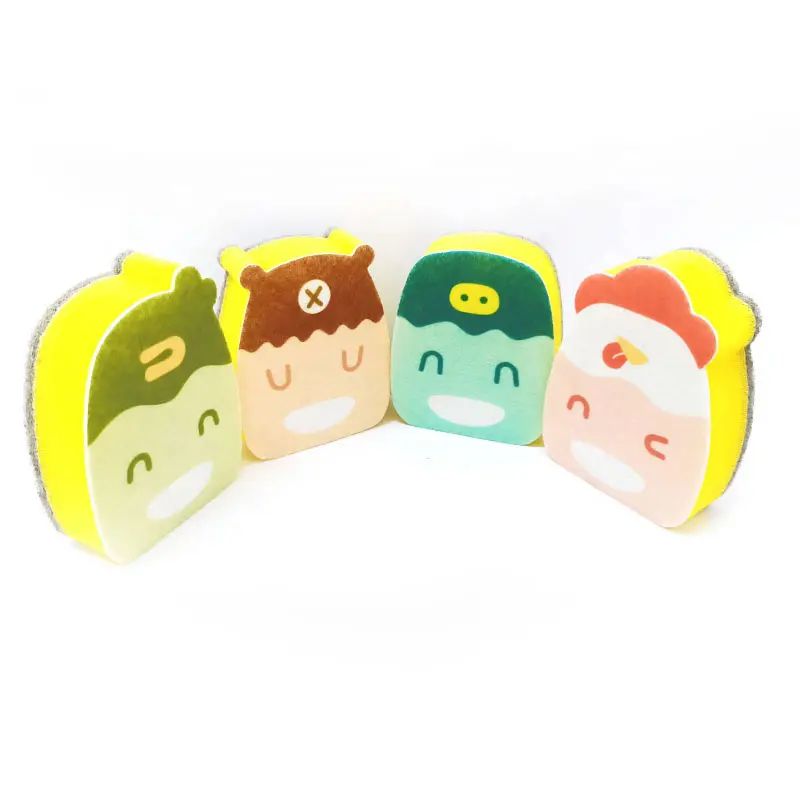
Soft Sponges: Gentle Yet Effective for Delicate Surfaces
Soft sponges are known for their ability to clean delicate surfaces without causing scratches or damage. They are often made of materials that are gentle on finishes like glass, porcelain, or smooth plastic. Soft sponges can be used to clean a variety of household items, including dishes, countertops, and surfaces that require a more delicate touch.
Key Benefits of Soft Sponges:
- Scratch-Free Cleaning: Soft sponges are ideal for surfaces that are prone to scratching. Whether it’s a non-stick pan, a glass tabletop, or a polished counter, soft sponges won’t leave marks or damage the finish.
- Gentle on Sensitive Items: Items like fine china, crystal glasses, and delicate cookware require extra care. Soft sponges are perfect for such items as they can effectively remove grease and food remnants without compromising their structural integrity.
- Prevention of Surface Damage: When you use a soft sponge, you’re less likely to cause microabrasions or permanent damage to the material. For example, when cleaning granite or marble countertops, using a hard sponge could lead to scuff marks or dullness, but a soft one will keep the surface pristine.
Types of Soft Sponges
Soft sponges come in various materials, each offering different cleaning advantages. Common types include:
- Cellulose Sponges: These sponges are made from plant fibers and are highly absorbent. They are often used for light cleaning tasks such as wiping down counters or washing dishes.
- Microfiber Sponges: Known for their ability to trap dirt and dust particles, microfiber sponges are also soft and gentle. They are particularly popular for cleaning sensitive electronics or delicate surfaces without leaving lint behind.
- Polyurethane Sponges: These sponges are soft yet durable, making them perfect for cleaning delicate surfaces. They can be used on both dry and wet surfaces, providing versatility without scratching.
Appropriate Uses for Soft Sponges
- Dishes and Cookware: Soft sponges are ideal for washing dishes that have sensitive coatings, such as non-stick pans or glassware, which can be easily scratched with harsh abrasives.
- Countertops: Kitchen and bathroom countertops, especially those made of granite, marble, or quartz, benefit from a gentle sponge that doesn’t damage their smooth surfaces.
- Delicate Items: Fine china, antiques, and glass items should be cleaned with a soft sponge to ensure they remain in good condition over time.
Slightly Harder Sponges: Tough on Stains, Gentle on Surfaces
On the other hand, slightly harder sponges are designed to tackle tougher cleaning challenges, such as sticky residues or stubborn stains. These sponges are slightly more abrasive than their soft counterparts but still gentle enough not to damage most surfaces. Slightly harder sponges often have a scrubbing side that is made from materials such as scouring pads or a more coarse material.
Key Benefits of Slightly Harder Sponges:
- Effective on Stubborn Stains: When you have stubborn grease stains on kitchen walls or soap scum in the bathroom, a slightly harder sponge will be more effective at scrubbing away the residue without excessive effort.
- Non-Damaging to Most Surfaces: Unlike very hard sponges, slightly harder ones still maintain a balance between abrasiveness and safety. They are often used for more robust cleaning jobs but will not severely scratch or damage most surfaces.
- Better at Removing Tough Build-Up: Whether it’s built-up grime on bathroom tiles or grease stains on stovetops, a harder sponge has the power to break down dirt and residue that a soft sponge might not be able to touch.
Types of Slightly Harder Sponges
- Nylon Scrubbers: These are typically used to scrub tough stains from hard surfaces like stainless steel, bathroom tiles, and kitchen stovetops. They are durable and resistant to wear.
- Scouring Pads: Made of abrasive materials, these pads are effective in removing heavy stains, especially in kitchens where grease can build up over time.
- Fiberglass Scrubbers: A more industrial-grade option, these sponges are designed to handle heavy-duty cleaning without damaging surfaces.
Appropriate Uses for Slightly Harder Sponges
- Tough Stains: A slightly harder sponge is the right choice for surfaces that have accumulated grime over time, such as grease splatters in the kitchen or soap scum on bathroom tiles.
- Cleaning Bathroom Walls and Bathtubs: When scrubbing shower walls or bathtubs, a slightly harder sponge can help remove soap residue and hard water stains without damaging the tile or tub surface.
- Removing Rust or Mineral Deposits: A slightly harder sponge can also be used to remove rust or mineral deposits on items like faucets or kitchen sinks.
Soft vs. Hard: Choosing the Right Sponge for the Job
Choosing the right sponge for a cleaning task comes down to the level of toughness you need without risking damage to the surface. Here’s a breakdown of when to choose soft sponges versus slightly harder sponges:
| Cleaning Task | Recommended Sponge | Reason |
|---|---|---|
| Washing delicate dishes | Soft Sponge | Gentle on non-stick surfaces, glassware, and fine china. |
| Cleaning counters (granite, marble) | Soft Sponge | Soft sponges prevent scratches and maintain the smooth finish of countertops. |
| Scrubbing grease stains from walls | Slightly Hard Sponge | More effective at cutting through grease without damaging the paint. |
| Cleaning soap scum from bathtubs | Slightly Hard Sponge | Provides enough abrasiveness to remove soap scum and mildew without scratching. |
| Removing hard water deposits | Slightly Hard Sponge | A more abrasive surface helps remove mineral build-up in sinks and faucets. |
| Scrubbing tile grout | Slightly Hard Sponge | Tough enough to scrub grout lines but gentle on tiles. |
5. Cleaning Performance of Cellulose Sponges
Cellulose sponges have long been a go-to cleaning tool for homes, kitchens, and various industrial applications. Their unique design and composition offer a blend of versatility, efficiency, and eco-friendliness. However, like any cleaning tool, not all cellulose sponges are created equal. Their cleaning performance can vary significantly, particularly when it comes to specific cleaning tasks like removing grease, food residue, or heavy-duty dirt. Understanding how different features of a cellulose sponge contribute to its cleaning power is essential for selecting the right sponge for various tasks.
Porous Design: The Key to Cleaning Efficiency
One of the primary factors that influence the cleaning performance of a cellulose sponge is its porous design. Cellulose sponges are made from plant-based materials, primarily wood pulp, which is processed into an absorbent, porous structure. This structure plays a vital role in the sponge’s cleaning performance.
Fine Pores vs. Coarse Pores
The effectiveness of a cellulose sponge in capturing and removing dirt largely depends on the size and number of pores within its structure. A sponge with finer pores has a larger surface area that allows it to trap more dirt, grease, and liquids. This can significantly improve its cleaning power, especially when dealing with fine particles such as dust or food residue. Additionally, the small pore structure helps retain more cleaning solution, making the sponge more efficient when used with soap or detergent.
On the other hand, a coarser pore structure is typically better at handling larger debris and is often more effective for scrubbing away heavier stains or grime. However, while coarser sponges may excel in removing visible dirt, they are less efficient at capturing fine particles, which can leave some residue behind.
| Pore Structure | Cleaning Performance | Best For |
|---|---|---|
| Fine Pores | Higher dirt capture, better for absorbing liquids and fine residue | Light cleaning tasks like wiping counters, dishes |
| Coarse Pores | Stronger scrubbing ability, better for tough dirt removal | Heavy-duty cleaning tasks like scrubbing greasy pots |
Absorbency and Dirt Removal
The absorbency of a cellulose sponge is another crucial factor in its cleaning performance. Cellulose sponges can absorb multiple times their weight in water, which means they can hold onto cleaning solutions longer. This helps to dissolve and lift dirt more efficiently, particularly when dealing with greasy or sticky substances. A highly absorbent sponge will also retain liquid for a longer period, allowing it to perform more thorough cleaning with fewer passes over the surface.
Specific Surface Treatments: Enhancing Performance and Hygiene
Another aspect that can significantly affect the cleaning performance of cellulose sponges is the application of surface treatments. Cellulose sponges, like many modern cleaning products, often undergo special treatments that enhance their performance and lifespan.
Antimicrobial Treatments
One of the most common treatments for cellulose sponges is the addition of antimicrobial agents. These agents are designed to prevent the growth of bacteria, mold, and mildew on the sponge. Since sponges are often used in wet environments, they are prone to developing bacterial growth that can lead to unpleasant odors and, more importantly, the spread of harmful bacteria.
Antimicrobial treatments in cellulose sponges work by introducing substances like silver ions, chlorine compounds, or other antimicrobial chemicals that inhibit the growth of microorganisms. By keeping bacteria at bay, these treatments can help maintain the sponge’s cleanliness for a longer period, reducing the need for frequent washing or replacement.
Benefits of Antimicrobial Treatments:
- Improved Hygiene: Reduces the chances of cross-contamination when cleaning surfaces, especially in food-preparation areas.
- Extended Lifespan: Antimicrobial-treated sponges last longer without developing unpleasant smells or harboring harmful microbes.
- Enhanced User Experience: The ability to use the sponge for a longer time without the need for constant rinsing or washing improves convenience.
However, it’s important to note that antimicrobial treatments cannot completely prevent bacterial growth if the sponge is not properly maintained. Even with these treatments, regular washing and drying are essential to keep the sponge in optimal condition.
Oil and Grease Resistance
Another type of surface treatment that can be applied to cellulose sponges is oil and grease resistance. Some sponges are specially designed to withstand oily and greasy substances, such as those commonly encountered in kitchens. These sponges are treated with chemicals that make them less likely to absorb oils, allowing them to scrub grease off surfaces more effectively.
This type of treatment is particularly useful for cleaning greasy kitchen surfaces, such as stovetops, counters, or even dishes. It also helps prevent the sponge from becoming overly saturated with greasy liquids, which can make cleaning tasks more difficult and less efficient.
Cleaning Performance for Specific Tasks
Different cleaning tasks demand different sponge characteristics. Understanding the specific needs of the task at hand can help you choose the best cellulose sponge for the job.
Grease Removal
Grease is one of the toughest substances to clean, especially in the kitchen. Whether you’re cleaning up after frying food or wiping down oily kitchen surfaces, the sponge’s ability to handle grease is crucial. For these tasks, sponges with a coarser pore structure and grease-resistant treatments are recommended. These sponges are typically better at lifting grease off surfaces without simply spreading it around.
Food Residue Removal
When it comes to removing food residue from dishes, counters, or cookware, the fine pore structure of a sponge is more suitable. Fine pores can trap small particles, like crumbs or sauce splashes, ensuring that the surface is properly cleaned. Antimicrobial-treated sponges also provide an additional layer of hygiene by preventing bacteria from developing on the sponge after it has come into contact with food residues.
General Cleaning and Wiping
For everyday cleaning tasks, such as wiping counters or cleaning dishes, a medium-pore sponge with good absorbency is usually the most versatile. These sponges are able to capture dirt, absorb liquids, and handle a variety of messes without being too specialized for a single task.
Durability and Maintenance: Ensuring Long-Term Cleaning Performance
In addition to surface treatments and pore design, a cellulose sponge’s durability plays a significant role in its cleaning performance over time. A durable sponge will continue to perform effectively, maintaining its cleaning power even after extended use.
The durability of cellulose sponges can be influenced by factors like:
- Quality of raw materials used in production.
- Construction techniques, such as whether the sponge is made with reinforced edges or if it has extra layers for additional strength.
- Regular maintenance (e.g., rinsing and drying the sponge properly after use) to prevent wear and tear.
While antimicrobial treatments can prolong the lifespan of a sponge, proper care is essential for maintaining cleaning performance. Regular washing and allowing the sponge to air dry can prevent it from becoming a breeding ground for bacteria and help it stay effective for a longer period.
6. Environmental Protection
With the growing concern over the health of our planet, more people are turning to eco-friendly cleaning products as a means to reduce their carbon footprint and minimize environmental harm. Among the various cleaning products available, natural cellulose sponges have gained popularity due to their biodegradable nature and chemical-free composition. These sponges provide an effective and sustainable alternative to conventional synthetic sponges that often contain harmful materials.
6.1 Biodegradable Sponges: A Step Towards a Greener Future
The concept of biodegradability is key to understanding the environmental advantages of natural cellulose sponges. Biodegradable products are those that can be broken down by natural processes into simpler substances, such as water, carbon dioxide, and organic matter. This process is facilitated by microorganisms, which degrade the material into its natural components over time.
6.1.1 The Benefits of Biodegradable Materials
Natural cellulose sponges are primarily made from plant fibers, most commonly wood pulp, which is a renewable resource. These fibers are naturally biodegradable, meaning they will not persist in the environment for hundreds of years like synthetic materials, such as plastic. When cellulose sponges are discarded, they break down into harmless components, reducing the burden on landfills and preventing the release of toxic substances into the environment.
In contrast, synthetic sponges, often made from petrochemicals like polyester or polyurethane, do not decompose easily. As a result, they can take centuries to break down, contributing to the growing issue of plastic pollution. By opting for biodegradable cellulose sponges, consumers are helping to reduce the amount of non-degradable waste that ends up in landfills or the ocean, where it can harm wildlife and disrupt ecosystems.
6.1.2 Reducing the Environmental Impact
The production of cellulose sponges generally has a smaller carbon footprint compared to synthetic sponges. This is because plant-based materials require less energy and fewer resources to produce. Additionally, cellulose sponges are often produced using less harmful chemicals during the manufacturing process, further reducing their environmental impact. By choosing biodegradable sponges, consumers contribute to a more sustainable supply chain and help decrease the environmental burden associated with conventional cleaning products.
The ability of biodegradable sponges to break down naturally also means that they are less likely to contribute to microplastic pollution. Microplastics have become a significant environmental concern in recent years, as small plastic particles are found in oceans, rivers, and even in the air. These particles can be harmful to marine life and human health. Since cellulose sponges decompose organically, they do not contribute to this widespread problem.
6.2 Chemical-Free Sponges: A Safer Choice for Health and the Environment
Another crucial aspect of eco-friendly cellulose sponges is their chemical-free composition. Unlike conventional cleaning sponges, which may contain harsh chemicals like dyes, fragrances, or artificial additives, natural cellulose sponges are free from these potentially harmful substances. This makes them not only safer for the environment but also for human health.
6.2.1 The Dangers of Chemicals in Conventional Cleaning Products
Many traditional cleaning products, including sponges, are treated with chemicals that can be harmful to both humans and the environment. For example, synthetic sponges may be treated with chemicals to make them more durable or to add scent. These chemicals can leach out of the sponge during use and end up in water systems, where they may contaminate the environment. Some of these chemicals, such as phthalates or bisphenol A (BPA), are endocrine disruptors and can cause long-term health problems when exposed to humans or animals.
In contrast, natural cellulose sponges are typically untreated, containing no added chemicals. This makes them a healthier choice for households with children, pets, or individuals with allergies or sensitivities. When the sponges are disposed of, there is no risk of toxic chemicals leaching into the environment, further reducing their ecological impact.
6.2.2 Safer for Water Systems
Water contamination is a major environmental issue, with industrial and household chemicals often making their way into rivers, lakes, and oceans. The chemicals found in cleaning products can disrupt aquatic ecosystems, harm aquatic life, and even enter the food chain. By choosing chemical-free, biodegradable sponges, consumers help reduce the release of harmful substances into water systems, protecting both wildlife and human health.
One of the key reasons for the environmental impact of cleaning products is the phosphates often found in detergents and other cleaning agents. These phosphates contribute to nutrient pollution, which can lead to algal blooms in water bodies. These blooms deplete oxygen levels, suffocating fish and other marine life. By choosing eco-friendly sponges that are free from chemical additives, individuals can play a role in minimizing nutrient pollution.
6.3 The Lifecycle of Natural Cellulose Sponges
To better understand the environmental benefits of biodegradable and chemical-free sponges, it is helpful to consider their lifecycle. The lifecycle of a product refers to all stages from production to disposal, and it is a useful tool for assessing the environmental impact of a product.
Below is a simplified lifecycle analysis of natural cellulose sponges:
| Stage | Environmental Impact |
|---|---|
| Production | Minimal environmental impact due to the use of plant-based materials, reducing carbon footprint. |
| Usage | Chemical-free, reducing exposure to harmful substances. Reusable and durable. |
| End of Life | Biodegradable and will break down into harmless organic matter, reducing landfill waste. |
| Environmental Benefit | Helps prevent microplastic pollution and chemical contamination in water systems. |
The lifecycle of natural cellulose sponges clearly shows their minimal environmental impact compared to synthetic alternatives. From production to disposal, these sponges provide a cleaner, greener solution for everyday cleaning tasks.
6.4 Choosing the Right Eco-Friendly Sponge
While natural cellulose sponges offer many environmental benefits, not all sponges are created equal. Consumers looking for eco-friendly options should consider several factors when choosing a sponge:
- Source of Materials: Look for sponges made from sustainably sourced plant fibers, such as wood pulp or cotton.
- Certification: Check for certifications like FSC (Forest Stewardship Council) or other sustainability labels that indicate the sponge is produced with minimal environmental impact.
- Reusability: Opt for sponges that can be used multiple times before needing to be replaced. This reduces waste and maximizes the environmental benefits.
- Packaging: Choose sponges that come in minimal, recyclable, or compostable packaging to further reduce waste.
7. Usage Scenario
Choosing the right sponge for your cleaning needs is essential for achieving effective and efficient cleaning results. Not all sponges are created equal, and the type of sponge you use can greatly impact the quality of the cleaning process, as well as the durability of surfaces being cleaned.
Kitchen Cleaning: High Absorbency and Firmness
The kitchen is often the most used area in a home, and it can become dirty quickly due to cooking activities. Grease, food residue, liquids, and crumbs accumulate rapidly on countertops, dishes, stoves, and floors. To make kitchen cleaning more effective, it is important to choose a sponge that is designed for heavy-duty tasks.
Key Features for Kitchen Sponges:
-
High Absorbency: A good kitchen sponge should have the ability to soak up liquids quickly and efficiently. Whether you’re wiping down countertops, cleaning greasy pans, or soaking up spills, the sponge needs to hold onto liquids without dripping. Natural cellulose sponges or synthetic sponges with high absorbency are ideal choices.
-
Firm or Medium Firmness: A sponge with a firmer texture helps tackle tough stains and food debris. When cleaning dishes, pots, or stovetops, a firm sponge will scrub without damaging surfaces. The medium firmness is perfect for delicate yet messy cleaning, such as wiping off grease or food residue.
-
Durability: In the kitchen, sponges will need to endure rigorous cleaning tasks. It’s important to choose a sponge that will not break down or wear out too quickly. Sponges made of durable materials such as synthetic foam or polyester are better suited for long-term use.
Ideal Sponge Types for Kitchen Use
There are various types of sponges designed specifically for kitchen use. The most common options include:
-
Cellulose Sponges: These sponges are made from natural wood pulp and are highly absorbent. They work well for general kitchen cleaning, including wiping countertops and cleaning dishes.
-
Scouring Pads: These pads often have a rough side, which makes them ideal for scrubbing pots, pans, and other cooking utensils with tough stains. They are generally made from materials like nylon or stainless steel.
-
Sponge Cloths: These offer the best of both worlds, with the absorbency of a sponge and the versatility of a cloth. They are great for wiping up spills and cleaning surfaces without leaving scratches.
How to Use Kitchen Sponges Effectively
- For Cleaning Grease and Oil: A firm sponge with a rougher side works best to scrub grease off stovetops and ovens.
- For General Wiping and Surface Cleaning: Use a soft, absorbent cellulose sponge to wipe down counters, sinks, and tables after meal prep or cooking.
- For Dishwashing: A medium-firm sponge with a gentle scrubbing side can clean delicate dishes without scratching them.
Bathroom Cleaning: Soft Sponges with Antibacterial Properties
The bathroom is a high-moisture environment where mold, soap scum, and mildew can thrive. To keep your bathroom clean, it is important to use a sponge that can effectively clean surfaces without causing damage. A soft, antibacterial sponge can make bathroom cleaning easier, as it can prevent the growth of harmful bacteria and mold.
Key Features for Bathroom Sponges:
-
Softness: Soft sponges are ideal for cleaning delicate bathroom surfaces like tiles, shower doors, and faucets. These surfaces can easily be scratched by rough materials, so it is important to use a sponge that is gentle yet effective in removing soap scum and grime.
-
Antibacterial Properties: Bathrooms are breeding grounds for bacteria, so it is beneficial to choose a sponge with antibacterial properties. This will help in preventing the growth of bacteria within the sponge itself, ensuring hygienic cleaning.
-
Resistance to Mold and Mildew: Since bathrooms have high humidity, it is important to use a sponge that resists mold and mildew growth. A synthetic sponge with antimicrobial agents or a specialized mildew-resistant sponge is ideal for this purpose.
Ideal Sponge Types for Bathroom Use
-
Antibacterial Sponges: These sponges are designed with antimicrobial properties that help to fight the growth of bacteria, fungi, and mold. They are especially useful for cleaning bathroom areas prone to moisture and bacteria buildup, such as shower walls and sinks.
-
Soft Scrub Sponges: These are gentle yet effective at removing soap scum, hard water stains, and other debris without scratching delicate bathroom surfaces like ceramic tiles, glass shower doors, and faucets.
-
Microfiber Sponges: Microfiber sponges are another great option for bathroom cleaning. They are soft, highly absorbent, and efficient at picking up dust, grime, and soap scum. The fibers also have natural antibacterial properties, making them a good choice for bathroom cleaning.
How to Use Bathroom Sponges Effectively
- For Cleaning Soap Scum and Water Stains: A soft, non-abrasive sponge with mild soap works best on glass shower doors and tiles.
- For Scrubbing Bathtubs and Sinks: Use an antibacterial sponge to scrub bathtubs, sinks, and faucets. This helps eliminate bacteria while cleaning.
- For Cleaning High-Humidity Areas: Microfiber sponges are effective for drying off wet areas and absorbing moisture from places like mirrors and shower walls.
General Household Cleaning: Versatility Without Scratches
For everyday cleaning around the house, a sponge that is versatile enough to handle multiple cleaning tasks while being gentle on surfaces is key. These sponges should be able to clean everything from light dusting to tougher grime without leaving scratches or causing damage to surfaces.
Key Features for General Household Sponges:
-
Multi-purpose Use: A good general household sponge should be able to handle a variety of tasks, from wiping down tables to cleaning bathroom counters. It should be neither too soft nor too firm, offering a balance of absorbency and scrubbing power.
-
Scratch Resistance: Whether you’re cleaning delicate surfaces such as glass tables, non-stick cookware, or polished wood, it’s crucial to choose a sponge that is gentle enough to avoid scratching.
-
Durability and Longevity: Since general household sponges are used for many types of cleaning, durability is important. Sponges made from high-quality synthetic materials, such as polyurethane or polyester, tend to last longer and maintain their effectiveness even after multiple uses.
Ideal Sponge Types for General Household Use
-
Multi-purpose Cellulose Sponges: These sponges are a great choice for general household cleaning because of their versatility and absorbency. They can be used on countertops, appliances, sinks, and even in the bathroom.
-
Foam Sponges: Foam sponges are lightweight, easy to use, and suitable for general cleaning. They are often less abrasive than other sponges, making them a good option for delicate surfaces.
-
Nylon Scrub Sponges: These are ideal for tougher jobs like cleaning pots and pans or scrubbing out grease. They offer a rougher texture but are still gentle enough to avoid leaving scratches on most surfaces.
How to Use General Household Sponges Effectively
- For Dusting and Surface Wiping: A soft cellulose or foam sponge is perfect for wiping down tables, shelves, and other surfaces without scratching them.
- For Kitchen and Bathroom Cleanup: Choose a sponge that combines absorbency with a gentle scrubbing texture to clean a variety of surfaces, including countertops, sinks, and floors.
- For Scrubbing Pots and Pans: A more durable, rough-textured sponge or scouring pad is needed to remove stubborn food debris from cookware.
Choosing the Right Sponge for Different Tasks
| Cleaning Area | Sponge Type | Firmness | Additional Features | Best for |
|---|---|---|---|---|
| Kitchen | Cellulose, Scouring Pad | Firm or Medium Firm | High absorbency, durable | Cleaning grease, food residue, dishes |
| Bathroom | Soft Scrub, Microfiber | Soft | Antibacterial, mildew-resistant | Cleaning soap scum, hard water stains |
| General Household | Cellulose, Foam, Nylon | Medium | Scratch-resistant, versatile | Multi-purpose cleaning, delicate areas |
PREVNo previous article
NEXTThe Ultimate Guide to Kitchen Clean Sponges: Types, Uses, and Maintenance
News Category
- Company News(31)
- Industry News(118)

 简体中文
简体中文 English
English 日本語
日本語 русский
русский Español
Español عربى
عربى